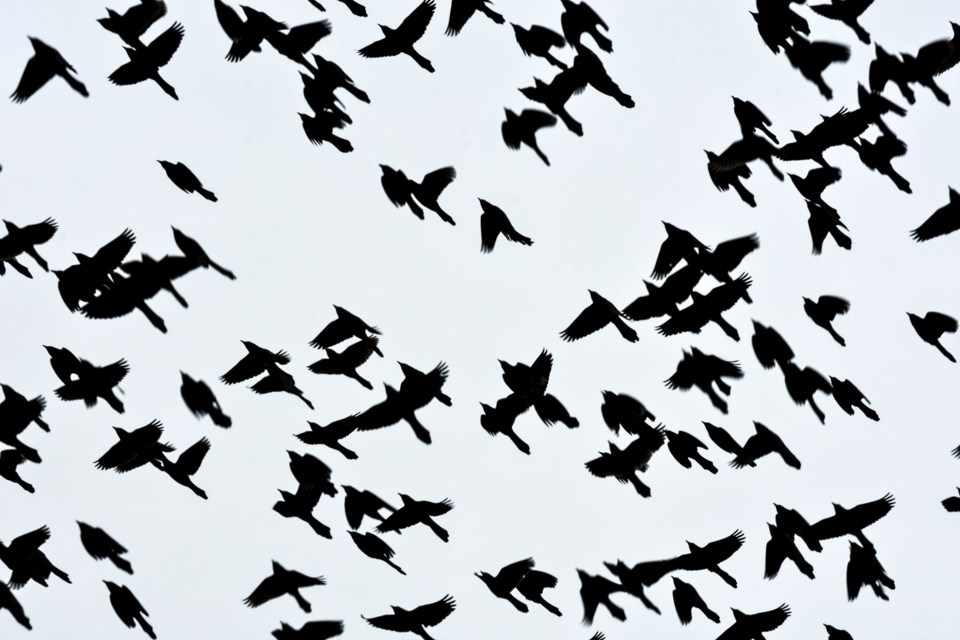Autumn is such a dynamic time of year with much hustle and bustle to be observed in nature, from the last ‘good bye’ party of warm-weather summer, to the spectacular cascade of tree colour and then the first icy kiss of winter. Lots going on out there.
This column has already looked at several migration events, from ducks to fish to butterflies, and today the focus is on one of the songbird species, the grackles. These birds are native to North America (not introduced ‘from across the pond’ as some like the starling have been) and are quite common in our area.
Looking like a regular blackbird that has been stretched a bit at both ends, grackles tend to hang out in large groups, sometimes numbering into the hundreds of thousands. During the summer they fan out across the land to build nests and raise young, but in autumn they converge in massive flocks to seek food in corn fields and woodlands.
You may have heard that the group name for crows is ‘a murder’; grackles have also been saddled with an equally ominous title… ‘a plague’. And from a corn grower's point of view, yep, I get it. When several thousand birds decide that your almost-ready-to-harvest corn crop would make a great roadside diner, nasty descriptors like plague do indeed come to mind.
Most bird migrations are long distance affairs, with the goal of the journey being to escape the bitter cold and land-covering snow. Grackles (and blue jays, which are a distant cousin) do indeed migrate, but just a bit of a short sashay across the map. Northern Ontario birds drop south to visit with us, while our summer friends dip down to Tennessee for their winter break.
One of the reasons for the shortened trek is that grackles are not picky eaters, as their diet covers everything from corn to acorns, and from weed seeds to the black oil sunflower seeds offered up at your bird feeder. In the summer they can catch minnows and frogs in the shallow wetlands, or eat baby cardinals fresh out of their egg shells.
At this time of year, there is usually a plethora of oak acorns available, eagerly sought by squirrels, bears, turkeys and yes, grackles. I have oft wondered just how a bird like a grackle can eat a whole acorn… and a bit of research has revealed an answer: inside the upper bill is a hard keel which is used to score the outside of the acorn.
Once the shell is weakened it can be bitten open and the soft innards of the acorn provide much needed protein and nutrients.
While raking the leaves yesterday (a chore that was lessened for two years because the moth caterpillars had eaten all the leaves) a seasonal sound came through our valley: the “chewink chewink” call of thousands upon thousands of grackles! Individually this call is not that exciting, but when multiplied by a factor of several thousand it becomes almost musical.
The birds seemed to be checking things out, trying to decide if the pickings would be better in the neighbour’s corn field or within the freshly raked lawn. The recently denuded maple tree was suddenly fully adorned with black ‘leaves’ as the first ‘plague’ settled in. The second squadron came up from the rear and flew on by, thus enticing the resting birds to take flight again and catch up.
You have to understand that these are not polite birds, as they will often steal food from other birds or from each other. So the thought of Flock B getting ahead of them was too much to bear, so away they all flew with much discussion and vocal encouragement to compete with those who dared pass them.
As these flocks gradually move south, one corn field at a time, their numbers will grow as one plague joins another. When a winter flock reaches several million in number it's hard to think that these are a declining species. Yet across North America their population has crashed from 190 million a few years ago to the current 70 million of today.
Even the International Union of Conservation for Nature has placed them on the Red List as “vulnerable”. Over-reaction you may ask? Well, um, let’s remember the fateful tale of the Passenger Pigeon.
It will soon be time to once again hang out the bird feeders and if there remain a few grackles in the neighbourhood you will get a close up view of these gregarious birds. And while they may not like the messy manner in which grackles feed, hey, it’s just their way of surviving the season.



